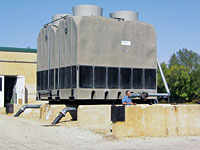
"We were spending between $5,000 and $10,000 a year on cooling tower repair - patching metal, putting in rubber seals, and gasketing," said Richer, referring to the cooling tower that supports the facility's HVAC equipment. "In other words, Band-Aid fixes just to keep the tower from leaking."
The cooling tower in question, installed in 1950, was being used on an absorption chiller to cool two facilities - the Brock Equipment plant and the adjacent Crystal Lake University Center, an educational facility for undergraduate studies and continuing education. Brock is owner of the Crystal Lake center.
"As the tower got older, not only did we have ongoing leak problems, we started to have a structural problem," said Richer. "The tanks that hold the water on the bottom were getting heavier as we added more materials to fix the leaks. All that weight was beginning to bend the structural members that held the cooling tank together."
Richer began investigating an alternative: engineered-molded plastic cooling towers, which are designed to be high-capacity, lightweight, and energy efficient.
"Given our choices, we were most likely going to install a new tower similar to the old one," said Richer. "But first I wanted to look into a new plastic type of cooling tower that was said to be more reliable and require less maintenance."
In the eyes of Richer, because engineered-molded plastic cooling towers are one piece, there are no problems with seams, welds, and patches that can wear prematurely. He also said they are price competitive.
REAL ESTATE CONSERVATION
Brock Equipment's cooling tower does not interface with manufacturing processes, but supports an absorption chiller that conditions facility air, a demanding application that is clearly affected by tower downtime. For this reason, the reduced maintenance requirements and extended life of molded plastic cooling towers were very appealing to Richer.In this case, Richer selected a unit manufactured by Delta Cooling Towers. The company said it produces units that are rotary-cast with a single- or double-wall UV-protected, polyethylene shell "that is virtually impervious to weather conditions and harsh environmental elements." The manufacturer also offers a 15-year warranty.
"If you are familiar with plastics, you know that engineered plastics are very tough. The new cooling tower has been trouble-free. We still have normal maintenance, but there has been no repair work on the tower, no leaks at all," said Richer.
The modular design of engineered plastic cooling towers has also introduced new flexibility in conserving valuable real estate, explained Richer.

Utility savings can also be realized by reducing the cost of electric power to drive cooling tower fans, he said. In the case of the engineered plastic towers from Delta Cooling, direct-drive motors are employed to power cooling fans. This is designed to provide energy savings while delivering more horsepower.
"The two motors installed on the old tower were each 40 horsepower, three-phase, 480 volts. On the new tower, there are four 10 horsepower motors," said Richer.
"So we now have only half the power requirement. Plus, the new motors are more efficient than the old ones. We have not measured the energy savings, but it's there."
Publication date: 05/22/2006

Report Abusive Comment